Apple PowerBook G4 DVI Service Manual

Service Source
PowerBook G4 (DVI)
Updated 4 December 2003
© 2003 Apple Computer, Inc. All rights reserved.

Service Source
Upgrades
PowerBook G4 (DVI)
© 2003 Apple Computer, Inc. All rights reserved.

PowerBook G4 (DVI)
Check for PowerBook G4 (DVI) 867 MHz Upgrade
Check for Upgraded Computer
Before you begin service procedures, check whether the computer has been upgraded with a PowerBook G4 (DVI) 867 MHz Upgrade Kit. Look at the computer’s ID label in the battery well to see if there is an Ethernet bar code label over the original Ethernet bar code, and a black dot in the upper right corner of the ID label.
In addition, the customer may also have a “Proof of Repair and Upgrade” sheet.
If so, the computer has been upgraded with a PowerBook G4 (DVI) 867 MHz Upgrade Kit.
The upgraded computer uses the following PowerBook G4 (1GHz/867MHz) parts:
•867MHz logic board (661-1799)
•DC-in board (922-5460)
•Heat exchanger (922-5445)
•Primary fan (922-5459)
•Secondary fan (922-5564)
Use only these parts, and refer to the PowerBook G4 (1GHz/867MHz) service manual (Updated 8 August 2003, or later) when performing service involving these parts.
Note: This computer upgrade is NOT available to service providers.
© 2003 Apple Computer, Inc. All rights reserved. |
Updated: 14 October 2003 |

PowerBook G4 (DVI)
Heat Exchanger Upgrade
Installation Instructions
The following instructions explain how to install the appropriate parts of the Heat Exchanger Upgrade Kit (076-1071) in the PowerBook G4 (DVI) computer.
Important: Use this chapter in conjunction with the take apart chapters. Only the exceptions are shown in this chapter. Perform these “exception” procedures at the appropriate points, and ignore the take apart procedures that do not apply.
Important: This kit is NOT for PowerBook G4 (DVI) 867 MHz upgraded computers. Refer to the “Check for PowerBook G4 (DVI) 867 MHz Upgrade” chapter of this manual to check for this computer upgrade.
Important: Some parts and procedures are different depending upon the configuration (667 MHz and 800 MHz). Verify the configuration and follow the procedures below:
Note: The kit consists of parts for both the 667 MHz and 800 MHz configurations. Verify that the kit contains the following:
•New version heat exchanger with ribbed extension
•Heat exchanger hold down bracket
•New version secondary fan (for 800 MHz units, only)
•(1) thick and (1) thin washer (for 667 MHz units, only)
Note: Kapton® tape is needed for the 667 MHz configuration and is not included in the kit.
© 2003 Apple Computer, Inc. All rights reserved. |
Updated: 4 December 2003 |
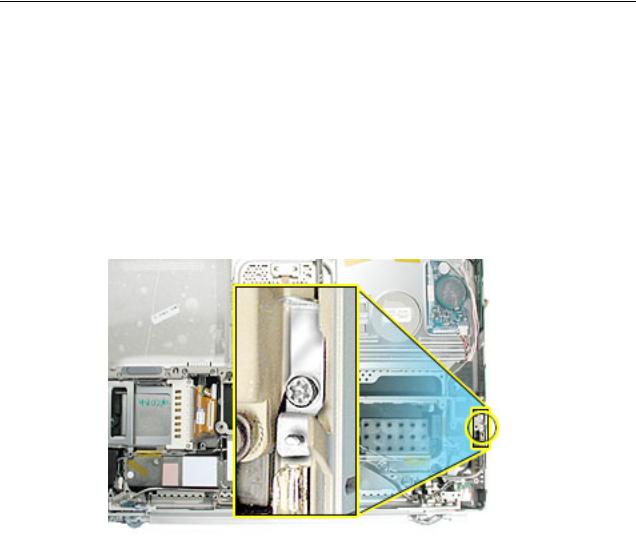
Procedure
For both configurations:
1.Remove the old heat exchanger and the secondary fan bracket (with fan, if present).
2.Install the new heat exchanger from the kit.
3.Install the heat exchanger hold-down bracket, as shown here. Use the screw that was removed from the rib frame at this location.
Replacement Note: Look from the side through the air vents of the top case to verify that the ribs on the heat exchanger do not block the vents.
Important: Before installing the logic board, verify that all thermal materials are installed on the new heat exchanger, and that all residual thermal material is removed from the logic board CPU chip, if any.
Important: If the heat exchanger has thermal material installed for the CPU chip, do not install thermal material onto the logic board chip.
PowerBook G4 (DVI) Heat Exchanger Upgrade - 2

For the 667 MHz configuration
This configuration does not use a secondary fan or bracket. A thin and thick washer will be installed.
1.With the screw removed from the DC-in board, center the thin washer over the screw hole in the board, then replace the screw, as shown.
Replacement Note: Make sure the DC connector is straight and centered in the port opening. The unplugged adapter connector may be inserted onto the DC connector to ensure that the connector is centered and straight before securing the DC-in board.
2.Center the thick washer over the screw hole shown below (this is a bottom case screw hole) and place Kapton tape over the top to secure it in place.
Important: Verify that the washer does not obstruct the screw hole.
PowerBook G4 (DVI) Heat Exchanger Upgrade - 3

For the 800 MHz configuration
This configuration uses the new secondary fan included in the kit.
1. Reroute the speaker wire and connector, as shown.
2. Install the secondary fan, as shown.
Replacement Note: Make sure the DC connector is straight and centered in the port opening. The unplugged adapter connector may be inserted onto the DC connector to ensure that the connector is centered and straight before securing the fan to the DC-in board.
PowerBook G4 (DVI) Heat Exchanger Upgrade - 4

Service Source
Take Apart
PowerBook G4 (DVI)
© 2003 Apple Computer, Inc. All rights reserved.

PowerBook G4 (DVI)
Keyboard
Replacement Instructions
Follow the instructions in this sheet carefully. Failure to follow these instructions could damage your equipment and void its warranty.
Note: Written and video instructions covering customer-installable parts are available at http://www.info.apple.com/installparts/.
Warning: During this procedure, keep small parts away from children.
Tools Required
The only tool required for this procedure is a jeweler’s flat-blade screwdriver (if keyboard is locked).
Removing the Installed Keyboard
Warning: Always shut down your computer before opening it to avoid damaging its internal components or causing injury. After you shut down the computer, the internal components can be very hot. Let the computer cool down before continuing.
1.Place your computer on a clean, flat surface.
2.Shut down your computer and wait thirty minutes before continuing.
3.Disconnect the power cord and any other cables connected to the computer.
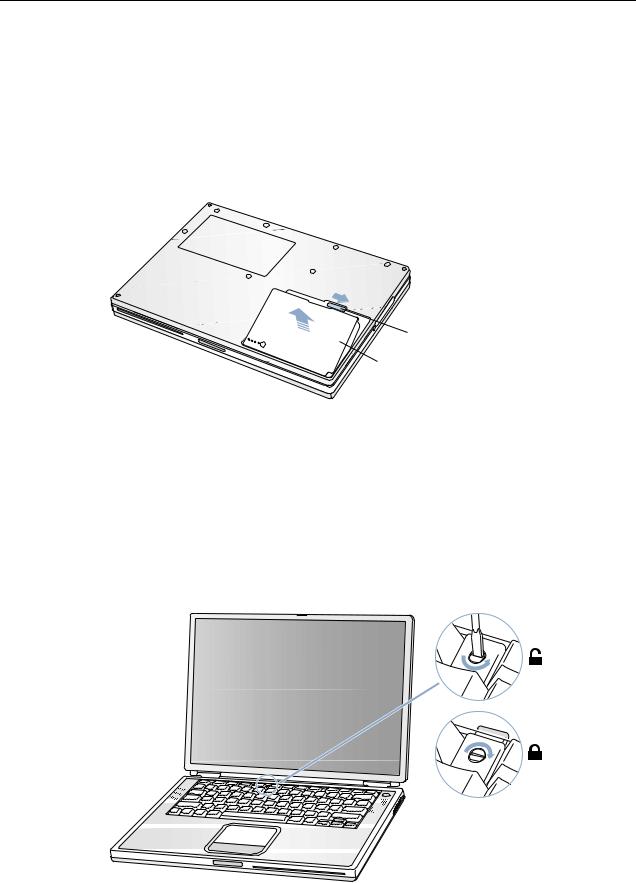
4.Close the computer and turn it over.
5.Slide the battery latch (Figure 1A) to the right to remove the battery (Figure 1B). Removing the battery will prevent you from accidentally turning on the computer.
Warning: Removing the battery before shutting down your computer may result in data loss.
Figure 1
A
6.Turn over the computer.
7.Raise the display so you can access the keyboard.
8.Make sure the keyboard locking screw, located in the small plastic tab to the left of the Num Lock key (Figure 2), is not in the locked position. Your PowerBook comes with the keyboard unlocked, so unless you or someone else locked the keyboard, you can skip this step.
To unlock the keyboard, turn the screw 1/2 turn.
Figure 2
PowerBook G4 (DVI) Keyboard - 2

9.Release the keyboard by pulling down on the keyboard release tabs (located to the left of the F1 and F12 keys) (Figure 3), then lift the top portion of the keyboard up slightly, and toward the display.
Figure 3
®
10. Flip the keyboard over and lay it on the palm rests and trackpad. (Figure 4)
Figure 4
PowerBook G4 (DVI) Keyboard - 3

11.Touch the computer’s inside framework (a dull gray conductive composite material) to discharge any static electricity, as shown (Figure 5).
Important: To avoid electrostatic discharge damage, always ground yourself by touching the computer’s framework before you touch any parts or install any components inside the computer. To avoid static electricity building back up in your body, do not walk around the room until you have completed your installation and closed the computer.
Figure 5
12. Locate the keyboard cable connector. (Figure 6)
Figure 6
13.Pull up on the connector, from side to side if needed, to disconnect it from the computer.
14.Set the keyboard aside.
PowerBook G4 (DVI) Keyboard - 4

Installing the Replacement Keyboard
1.Lay the replacement keyboard in the correct orientation over the keyboard opening, then flip it toward you and lay it face down on the palm rests and trackpad to expose its connector cable. (Figure 7)
Figure 7
2.Firmly insert the keyboard cable connector into its connector on the computer.
3.Flip the keyboard back toward the keyboard opening in the case.
4.Hold the keyboard at an angle above the keyboard opening, and insert the tabs on the bottom edge of the keyboard into the slots below the edge of the opening. (Figure 8)
Important: Make sure that all the tabs are seated and that the keyboard rests flush against the edge of the opening.
Figure 8
PowerBook G4 (DVI) Keyboard - 5

5.Lay the keyboard flat into the keyboard opening.
6.Pull down on the keyboard release tabs and then press down on the top portion of the keyboard. (Figure 9)
Figure 9
®
7.Release the tabs to secure the keyboard in place.
8.Close the display and turn the PowerBook over.
9.Replace the battery into the battery compartment. (Figure 10)
Important: Make sure that the battery locks securely into place and that the battery latch is slid all the way into the locked position.
Figure 10
10.Reconnect the power cord and any other cables that were connected, and restart your computer.
Warning: Never turn on your computer unless all of its internal and external parts are in place and it is closed. Operating the computer when it is open or missing parts can damage your computer or cause injury.
PowerBook G4 (DVI) Keyboard - 6

Apple Computer, Inc.
© 2002 Apple Computer, Inc. All rights reserved.
This document is protected under U.S. Copyright Law and International Treaties, and no part of this document may be reproduced in any form without written permission from Apple.
Apple is not responsible for typographical, printing, or inadvertent errors.
Apple Computer, Inc. 1 Infinite Loop
Cupertino, CA 95014-2084 USA
+ 1 408 996 1010 http://www.apple.com
Apple, the Apple logo, and PowerBook are trademarks of Apple Computer, Inc., registered in the U.S. and other countries.
PowerBook G4 (DVI) Keyboard - 7

PowerBook G4 (DVI)
Memory Card
Replacement Instructions
Follow the instructions in this sheet carefully. Failure to follow these instructions could damage your equipment and void its warranty.
Note: Written and video instructions covering customer-installable parts are available at http://www.info.apple.com/installparts/.
Warning: During this procedure, keep small parts away from children.
Tools Required
The only tool required for this procedure is a jeweler’s flat-blade screwdriver (if keyboard is locked).
Opening the Computer
Warning: Always shut down your computer before opening it to avoid damaging its internal components or causing injury. After you shut down the computer, the internal components can be very hot. Let the computer cool down before continuing.
1.Place your computer on a clean, flat surface.
2.Shut down your computer and wait thirty minutes before continuing.
3.Disconnect the power cord and any other cables connected to the computer.

4.Close the computer and turn it over.
5.Slide the battery latch (Figure 1A) to the right to remove the battery (Figure 1B). Removing the battery will prevent you from accidentally turning on the computer.
Warning: Removing the battery before shutting down your computer may result in data loss.
Figure 1
A
6.Turn over the computer.
7.Raise the display so you can access the keyboard.
8.Make sure the keyboard locking screw, located in the small plastic tab to the left of the Num Lock key (Figure 2), is not in the locked position. Your PowerBook comes with the keyboard unlocked, so unless you or someone else locked the keyboard, you can skip this step.
To unlock the keyboard, turn the screw 1/2 turn.
Figure 2
PowerBook G4 (DVI) Memory - 2

9.Release the keyboard by pulling down on the keyboard release tabs (located to the left of the F1 and F12 keys) (Figure 3), then lift the top portion of the keyboard up slightly, and toward the display.
Figure 3
®
10. Flip the keyboard over and lay it on the palm rests and trackpad. (Figure 4)
Figure 4
PowerBook G4 (DVI) Memory - 3

11.Touch the computer’s inside framework (a dull gray conductive composite material) to discharge any static electricity, as shown (Figure 5).
Important: To avoid electrostatic discharge damage, always ground yourself by touching the computer’s framework before you touch any parts or install any components inside the computer. To avoid static electricity building back up in your body, do not walk around the room until you have completed your installation and closed the computer.
Figure 5
Removing the Installed Memory Card
1.To remove a memory card, locate the brackets that secure the card on both sides (Figure 6). Carefully spread the brackets apart until the card releases on each side. Pull the card up and out.
Note: If there is a memory card in the upper memory slot (Figure 6A), it must be removed before removing a card in the lower slot (Figure 6B).
Figure 6
B A
PowerBook G4 (DVI) Memory - 4
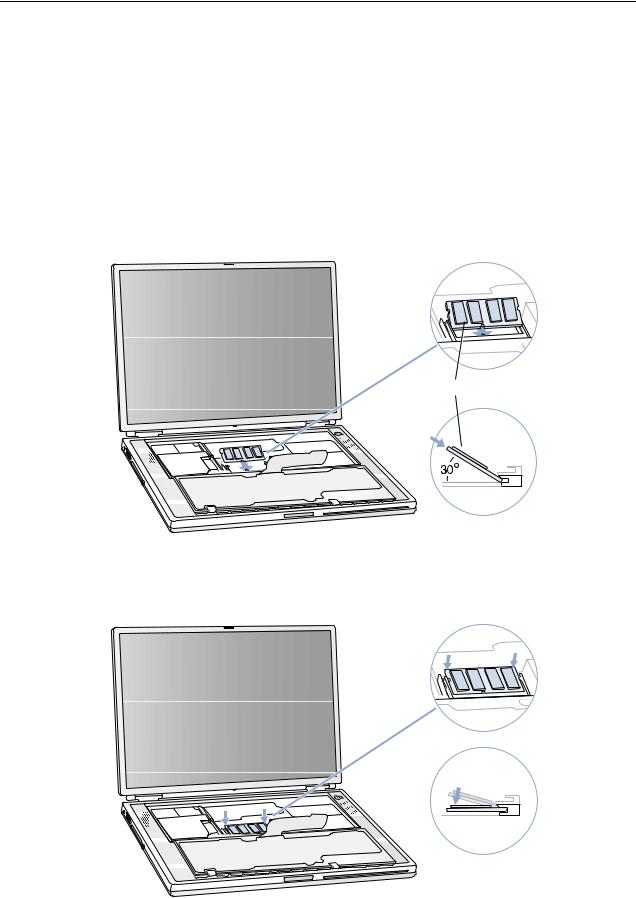
Installing the Replacement Memory Card
Warning: When handling a memory card, do not touch its gold connectors. Handle the card only by the edges.
1.To install the memory card, line up the notch in the card with the small tab in the memory slot. Hold the card at a 30-degree angle (Figure 7A), and then push the card into the slot until it is firmly seated.
Note: You may feel some resistance. If you are having trouble inserting the card, try pushing one side at a time.
Figure 7
A
2.Gently push the card down until the two brackets on either side of the card lock into place (Figure 8).
Figure 8
PowerBook G4 (DVI) Memory - 5

Closing the Computer
1.Flip the keyboard back toward the keyboard opening in the case.
2.Hold the keyboard at an angle above the keyboard opening, and insert the tabs on the bottom edge of the keyboard into the slots below the edge of the opening. (Figure 9)
Important: Make sure that all the tabs are seated and that the keyboard rests flush against the edge of the opening.
Figure 9
3.Lay the keyboard flat into the keyboard opening.
4.Pull down on the keyboard release tabs and then press down on the top portion of the keyboard. (Figure 10)
Figure 10
®
5. Release the tabs to secure the keyboard in place.
PowerBook G4 (DVI) Memory - 6
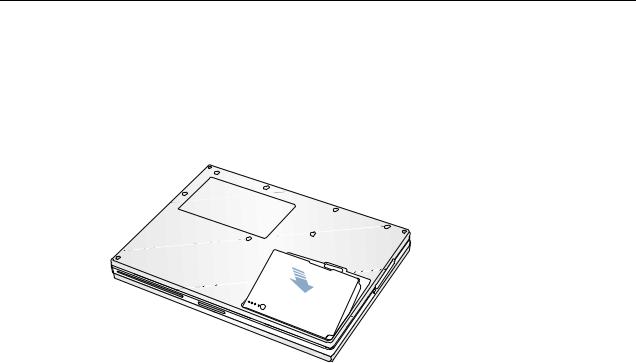
6.Close the display and turn the PowerBook over.
7.Replace the battery into the battery compartment. (Figure 11)
Important: Make sure that the battery locks securely into place and that the battery latch is slid all the way into the locked position.
Figure 11
8.Reconnect the power cord and any other cables that were connected, and restart your computer.
Warning: Never turn on your computer unless all of its internal and external parts are in place and it is closed. Operating the computer when it is open or missing parts can damage your computer or cause injury.
Apple Computer, Inc.
© 2002 Apple Computer, Inc. All rights reserved.
This document is protected under U.S. Copyright Law and International Treaties, and no part of this document may be reproduced in any form without written permission from Apple.
Apple is not responsible for typographical, printing, or inadvertent errors.
Apple Computer, Inc. 1 Infinite Loop
Cupertino, CA 95014-2084 USA
+ 1 408 996 1010 http://www.apple.com
Apple, the Apple logo, and PowerBook are trademarks of Apple Computer, Inc., registered in the U.S. and other countries.
PowerBook G4 (DVI) Memory - 7

PowerBook G4 (DVI)
Bottom Case
Replacement Instructions
Follow the instructions in this sheet carefully. Failure to follow these instructions could damage your equipment and void its warranty.
Note: Written and video instructions covering customer-installable parts are available at http://www.info.apple.com/installparts/.
Warning: Sharp edges can exist inside your computer and on any parts being removed or installed. Use caution to avoid injury. Keep small parts away from children.
Tools Required
•Soft towel or cloth, larger than the PowerBook
•Torx T8 screwdriver (provided with bottom case)
Removing the Bottom Case
Warning: Always shut down your computer before opening it to avoid damaging its internal components or causing injury. After you shut down the computer, the internal components can be very hot. Let the computer cool down before continuing.
1.Place your computer on a clean, flat surface.
2.Shut down your computer and wait thirty minutes before continuing.
3.Disconnect the power cord and any other cables connected to the computer.

4.Place a towel or soft cloth on a table in front of you. (Figure 1A)
The towel or cloth will protect the keyboard and display area of the PowerBook when you flip it over to remove the battery and bottom case. Make sure it covers an area large enough for your PowerBook and that it hangs over the edge of the table.
5.With the display open at an angle greater than 90 degrees, carefully flip the PowerBook over and lay it flat, fully on the table. Make sure the display hangs over the edge of the table and rests lightly on your lap. (Figure 1B)
Important: Do not open the display farther than the angle shown.
Figure 1
A
B
6.Remove the battery by sliding the battery latch to the left. Make sure to return the latch fully to the right. (Figure 2)
Removing the battery will prevent you from accidentally turning on the computer.
Warning: Removing the battery before shutting down your computer may result in data loss.
Figure 2
PowerBook G4 (DVI) Bottom Case - 2

7.Using the appropriate screwdriver, remove the eight bottom case screws in the order shown in the illustration. (Figure 3)
Important: To avoid damaging the case, be careful that the screwdriver tip does not slip out of the screw head during removal.
Figure 3
1
3
2
 4 7
4 7 

 6 5
6 5 
Note: The following three steps explain how to remove the bottom case by disengaging it at the left and right sides and then carefully pivoting it forward.
Important: During this procedure, do not push on the rubber feet of the bottom case.
8. Carefully slide the bottom case away from you. (Figure 4)
Figure 4
PowerBook G4 (DVI) Bottom Case - 3
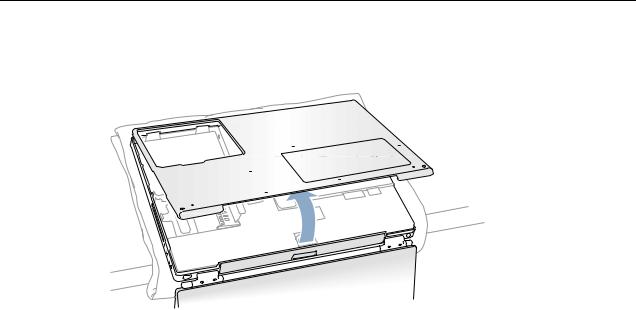
9. Pivot the bottom case up as shown in the illustration below. (Figure 5)
Figure 5
Installing the Replacement Bottom Case
1.To install the new bottom case, place it over the bottom of the computer in the same orientation as the original bottom case.
2.Align the notches on the right and left sides of the case (some of these can be viewed through the battery opening). Then press down and toward you slightly to secure the case.
Important: Make sure that the seams between the bottom case and the frame are closed. Verify that the case lies flat and fits properly around the battery latch and that the alignment tab that protrudes on the underside of the bottom case, shown in the illustration (Figure 6A), is seated properly.
Note: To help with alignment, apply pressure to the bottom case at the back of the battery compartment opening, near the latch, and on the front and back outside edges of the case.
3.Check that the eight screw holes on the case align with the holes on the computer.
PowerBook G4 (DVI) Bottom Case - 4
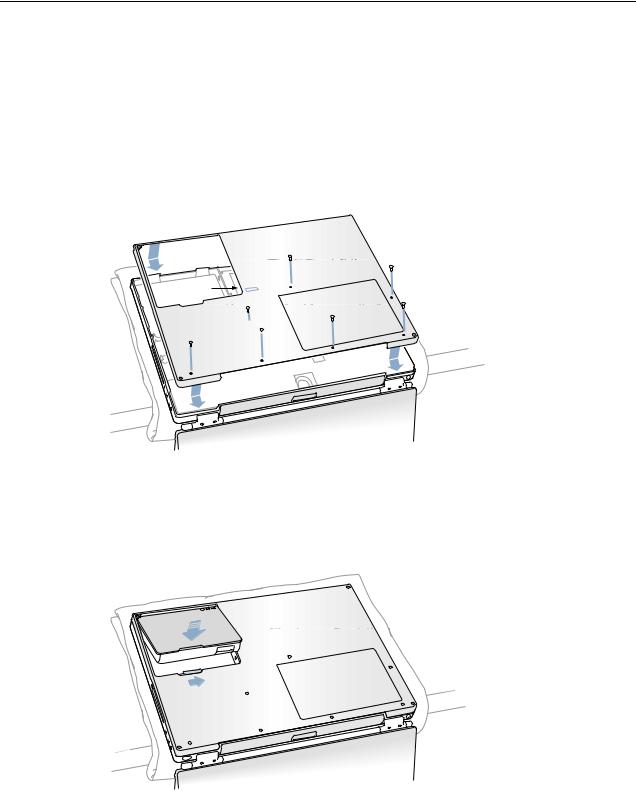
4.Replace the eight screws in the order shown in the illustration (Figure 6). Do not overtighten the screws or damage could result.
Note: The screws must go in straight and easily; if they do not, readjust the bottom case for proper alignment.
Important: To avoid damaging the case, be careful that the screwdriver tip does not slip out of the screw head during tightening.
Figure 6
7
5
A |
4 |
|
6 |
||
1 |
||
|
 2 3
2 3 
5. Replace the battery. (Figure 7)
Important: Make sure that the battery locks securely into place and that the battery latch is slid all the way into the locked position.
Figure 7
PowerBook G4 (DVI) Bottom Case - 5
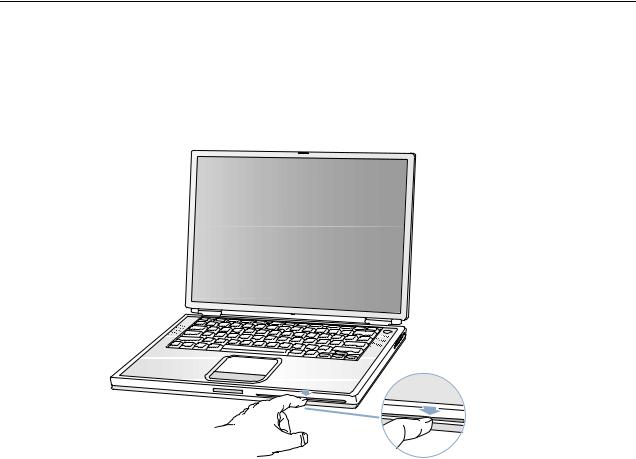
6.Turn the computer over so that the optical drive slot faces you. Verify that the bottom case is flush with the front edge of the slot. If the case is slightly bowed and there is a gap near the center of the slot, carefully pull the bottom edge of the slot until it clicks into place and becomes flush with the bottom case. (Figure 8)
Figure 8
®
7.Reconnect the power cord and any other cables that were connected, and restart your computer.
Warning: Never turn on your computer unless all of its internal and external parts are in place and it is closed. Operating the computer when it is open or missing parts can damage your computer or cause injury.
PowerBook G4 (DVI) Bottom Case - 6

Apple Computer, Inc.
© 2002 Apple Computer, Inc. All rights reserved.
This document is protected under U.S. Copyright Law and International Treaties, and no part of this document may be reproduced in any form without written permission from Apple.
Apple is not responsible for typographical, printing, or inadvertent errors.
Apple Computer, Inc. 1 Infinite Loop
Cupertino, CA 95014-2084 USA
+ 1 408 996 1010 http://www.apple.com
Apple, the Apple logo, and PowerBook are trademarks of Apple Computer, Inc., registered in the U.S. and other countries.
PowerBook G4 (DVI) Bottom Case - 7

PowerBook G4 (DVI)
AirPort Card
Replacement Instructions
Follow the instructions in this sheet carefully. Failure to follow these instructions could damage your equipment and void its warranty.
Note: Written and video instructions covering customer-installable parts are available at http://www.info.apple.com/installparts/.
Warning: Sharp edges can exist inside your computer and on any parts being removed or installed. Use caution to avoid injury. Keep small parts away from children.
Tools Required
•Soft towel or cloth, larger than the PowerBook
•Torx T8 screwdriver
Opening the Computer
Warning: Always shut down your computer before opening it to avoid damaging its internal components or causing injury. After you shut down the computer, the internal components can be very hot. Let the computer cool down before continuing.
To access the AirPort Card, you must first remove the battery and bottom case.
1.Place your computer on a clean, flat surface.
2.Shut down your computer and wait thirty minutes before continuing.
3.Disconnect the power cord and any other cables connected to the computer.
